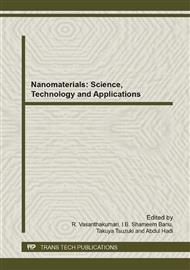[1]
A. Ahmad, P. Mukherjee, S. Senapati, D. Mandal, M.I. Khan, R. Kumar, Extracellular biosynthesis of silver nanoparticles using the fungus Fusarium oxysporum, Colloids Surf. B, 28 (2003) 313-318.
DOI: 10.1016/s0927-7765(02)00174-1
Google Scholar
[2]
M. Kowshik, S. Ashtaputre, S. Kharrazi, W. Vogel, J. Urban, S.K. Kulkarni, K.M. Paknikar, Extracellular synthesis of silver nanoparticles by a silver-tolerant yeast strain MKY3, Nanotechnology, 14 (2003) 95-100.
DOI: 10.1088/0957-4484/14/1/321
Google Scholar
[3]
M. Lengke, M. Fleet, G. Southam, Biosynthesis of silver nanoparticles by filamentous cyanobacteria from a silver (I) nitrate complex, Langmuir, 10 (2006) 1021-1030.
DOI: 10.1021/la0613124
Google Scholar
[4]
X. Jianping, Y.L. Jim, I.C.W. Daniel, P.T. Yen, Identification of active biomolecules in the high-yield synthesis of single-crystalline gold nanoplates in algal solutions, Small, 3 (2007) 668-672.
DOI: 10.1002/smll.200600612
Google Scholar
[5]
P. Srivastava, J. Bragança, S.R. Ramanan, M. Kowshik, Synthesis of silver nanoparticles using haloarchaeal isolate Halococcus salifodinae BK3, Extremophiles, 17 (2013) 821-831.
DOI: 10.1007/s00792-013-0563-3
Google Scholar
[6]
B. Zafrilla, R.M. Martínez-Espinosa, M.A. Alonso, M.J. Bonete, Biodiversity of Archaea and floral of two inland saltern ecosystems in the Alto Vinalopó Valley, Spain, Saline Syst., 6 (2010) 10 (doi: 10. 1186/1746-1448-6-10).
DOI: 10.1186/1746-1448-6-10
Google Scholar
[7]
P. Srivastava, M. Kowshik Mechanisms of metal resistance and homeostasis in haloarchaea. Archaea, 2013 (2013) 16 (doi: 10. 1155/2013/732864).
DOI: 10.1155/2013/732864
Google Scholar
[8]
R. Joerger, T. Klaus, C.G. Granqvist, Biologically produced silver-carbon composite materials for optically functional thin-film coatings, Adv. Mater., 12 (2000) 407-409.
DOI: 10.1002/(sici)1521-4095(200003)12:6<407::aid-adma407>3.0.co;2-o
Google Scholar
[9]
T. Vo-Dinh, Nanobiosensing using plasmonic nanoprobes, IEEE J. Sel. Topics Quantum Electron, 14 (2008) 198-205.
DOI: 10.1109/jstqe.2007.914738
Google Scholar
[10]
F. Furno, K.S. Morley, B. Wong, B.L. Sharp, P.L. Arnold, S. M/ Howdle, R. Bayston, P.D. Brown, P.D. Winship, Silver nanoparticles and polymeric medical devices: a new approach to prevention of infection? J. Antimicrob. Chemother., 54 (2004).
DOI: 10.1093/jac/dkh478
Google Scholar
[11]
F. Ramezani, M. Ramezani, S. Talebi, Mechanistic aspects of biosynthesis of nanoparticles by several microbes, Nanocon., 10 (2010) 12-14.
Google Scholar
[12]
K. Mani, B.B. Salgaonkar, J.M. Braganca, Culturable halophilic archaea at the initial and crystallization stages of salt production in a natural solar saltern of Goa, India, Aquatic Biosystems, 8 (2012) 15 (doi: 10. 1186/2046-9063-8-15).
DOI: 10.1186/2046-9063-8-15
Google Scholar
[13]
S.M. Harley, Use of a simple, colorimetric assay to demonstrate conditions for induction of nitrate reductase in plants, Am. Biol. Teach., 55 (1993) 161-164.
DOI: 10.2307/4449615
Google Scholar
[14]
R. Vaidyanathan, S. Gopalram, K. Kalishwaralal, V. Deepak, S.R. Pandian, S. Gurunathan, Enhanced silver nanoparticle synthesis by optimization of nitrate reductase activity, Colloids Surf. B, 75 (2010) 335-41.
DOI: 10.1016/j.colsurfb.2009.09.006
Google Scholar
[15]
V. Deepak, K. Kalishwaralal, S.R. Pandian, S. Gurunathan, An insight into the bacterial biogenesis of silver nanoparticles, industrial production and scale-up, in: M. Rai, N. Durán (Eds. ), Metal nanoparticles in microbiology, Springer-Verlag Berlin Heidelberg, 2011 pp.17-35.
DOI: 10.1007/978-3-642-18312-6_2
Google Scholar
[16]
M.M.G. Babu, J. Sridhar, P. Gunasekaran, Global transcriptome analysis of Bacillus cereus ATCC 14579 in response to silver nitrate stress, J. Nanobiotechnology, 9 (2011) 49 (doi: 10. 1186/1477-3155-9-49).
DOI: 10.1186/1477-3155-9-49
Google Scholar
[17]
J.S. Kim, E. Kuk, K.N. Yu, J.H. Kim, S.J. Park, H.J. Lee, S.H. Kim, Y.K. Park, Y.H. Park, C.Y. Hwang, Y.K. Kim, Y.S. Lee, D.H. Jeong, M.H. Cho, Antimicrobial effects of silver nanoparticles, Nanomedicine, 3 (2007) 95-101.
DOI: 10.1016/j.nano.2006.12.001
Google Scholar
[18]
M. Guzman, J. Dille, S. Godet, Synthesis and antibacterial activity of silver nanoparticles against gram-positive and gram-negative bacteria, Nanomed- Nanotechnol. Biol. Med., 8 (2012) 37-45.
DOI: 10.1016/j.nano.2011.05.007
Google Scholar


